A Galápagos Cruise Challenges the Mind, Body, and Spirit — Here's Why I'm Glad I Took My 7-year-old Son
Snorkeling with penguins and dining under the stars? An intimate cruise in the Galápagos Islands brings you up close to nature, but doesn’t skimp on luxury.
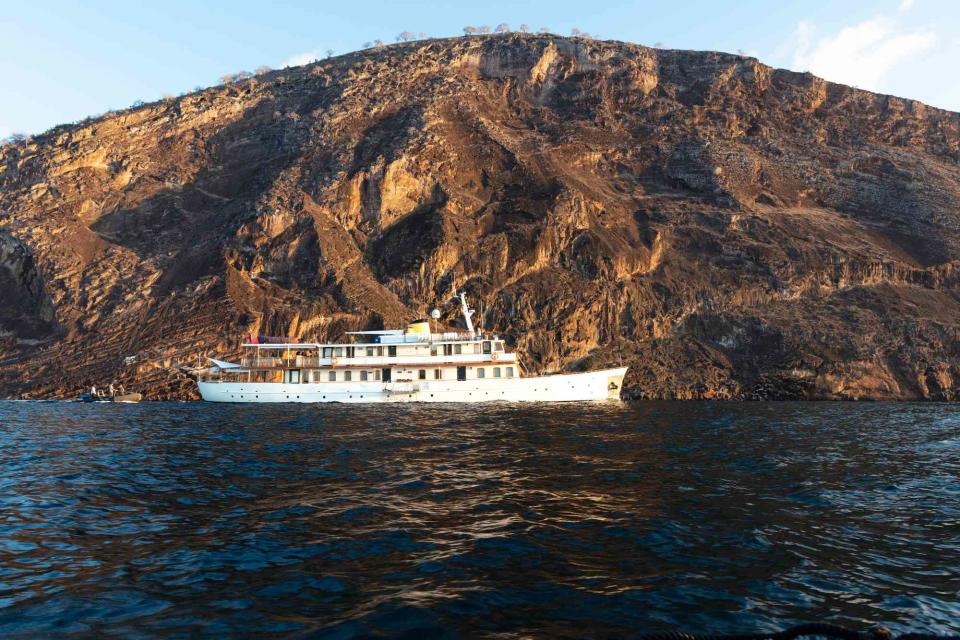
Courtesy of Quasar Expeditions
The 16-passenger Grace sails through the Galápagos Islands.The golden cownose rays eased silently through the lagoon, like fall leaves drifting down a stream. Every few seconds, a fin would break the surface, revealing the stark contrast of a white underbelly. The driver of our Zodiac cut the engine out of deference to the animals, and a silence quickly descended on the red mangroves, their thick roots sheltering countless other species just beneath.
Shouts from another inflatable raft broke the stillness. I was sitting with seven other passengers, all giddy to be exploring the waterways off Punta Moreno on Isabela Island — a seahorse-shaped landmass, the largest and one of the youngest in the volcanic chain that makes up the Galápagos. Our companion boat had caught up to us. My son, Bobby, and husband, Rob, who were in that group, were pointing at the triangular formation of rays. Look close!
Thick raindrops appeared, but neither the creatures nor the humans seemed bothered — it was just nature, running its course. I hope Bobby is paying attention, I said to myself, willing the thought across the water and into his impressionable yet wandering seven-year-old mind. Does he know how lucky he is? Do we know how lucky we are?
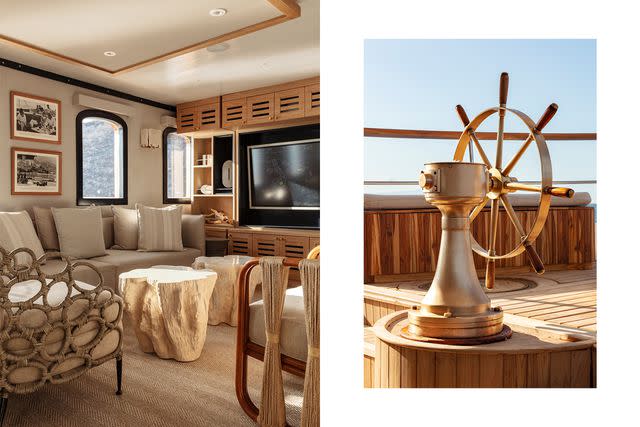
Courtesy of Quasar Expeditions
From left: The lounge aboard the Grace; the captain’s wheel.My family and I were on day five of our rigorous journey aboard the Grace, a 16-passenger yacht once gifted to Grace Kelly by Aristotle Onassis. I emphasize “rigorous” to banish the idea of this being a cocktails-with-your-feet-up kind of a vacation. Arguably more strenuous than most African safaris, a Galápagos cruise challenges the mind, body, and spirit. There were multiple snorkeling trips through the Pacific waves in heavy-duty wet suits as penguins darted by our flippers. Sweat-soaked hikes near volcanoes (yes, plural). Kayak excursions past flightless cormorants batting their devolved, stubby wings after a dip — they seemed prepared for the midday heat, while we suffered in useless hats.
“You’re going to need a vacation from your vacation,” joked our always-on cruise director, Scarlett Briones, part of the Grace’s 14-strong crew. Not long after our plane touched down on Baltra Island, in the center of the archipelago, we had spotted our first sea lion (highly thrilling at the time, but by the end of our trip they were NBD). He barked at us like an impatient toddler as we boated to the Grace. My not-so-shy son suddenly curled up by my side; the only sea lions we’d come this close to were at the Central Park Zoo.
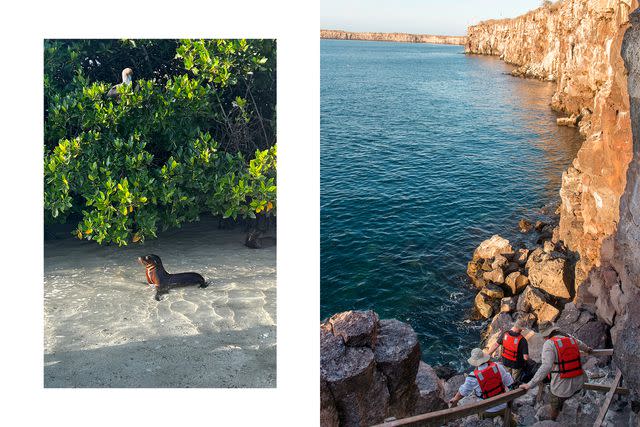
From left: Courtesy of Jacqueline Gifford; Wolfgang Kaehler/Alamy
From left: A sea lion on Genovesa Island; Prince Philip’s Steps, a natural rock formation on Genovesa Island.Two families — one from Seattle, the other from the New York City suburbs — were with us on the weeklong journey. We quickly made friends, lounging comfortably together on the yacht in bare feet and bathing suits within 24 hours of meeting. That may have been easier because of the intimate nature of the ship. Recently renovated by Enrique Concha & Co., a Chilean design firm, the Grace’s guest cabins, lounge, and open-air bar had been decorated in warm earth tones. And there was a place for everything. Our 183-square-foot room miraculously held a pullout bed for Bobby and all our gear: shoes, backpacks, more shoes, toiletries, more shoes. There was an alfresco hot tub for tired muscles, a top perch for sunbathing, and elegant meals, which we paired with Ecuadoran wines and enjoyed under the unfamiliar stars of the Southern Hemisphere.
Quasar Expeditions currently operates the Grace and one other vessel, the 32-passenger Evolution. (A new 18-guest yacht, the Conservation, will debut in December 2024.) The owners, the Diez family, are proud Ecuadorans who have had a presence in the islands since 1986. “There’s been a huge increase in multigenerational family travel,” Dolores Gangotena de Diez, the founder of Quasar, told me over dinner in the capital city of Quito just before our sailing. Years ago, she went on, the travelers were mostly intrepid retirees or marine biologists who didn’t mind taking timed showers. And of the few cruise ships that did operate in the region, most were not welcoming to children Bobby’s age.
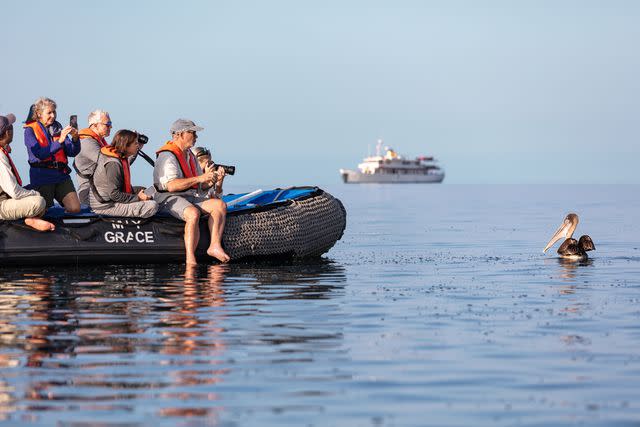
Courtesy of Quasar Expeditions
Viewing wildlife up close on one of the Grace’s two Zodiacs.In the past five years, Aqua Expeditions, Celebrity Cruises, and Silversea Cruises have debuted vessels that cater to those who expect to learn something while they’re being pampered (76 cruise ships are now allowed to visit the islands). In 2021, the protected waters around the archipelago were expanded by 23,000 square miles — making a total of 76,450 — to safeguard a critical marine migration route. And this past May, Ecuador completed the world’s largest “debt-for-nature” swap, a restructuring deal facilitated by Credit Suisse that led to the establishment of the $656 million Galápagos Marine Bond, which will fund future conservation.
What has remained the same: like every other cruise operator, Quasar follows strict itineraries, set by the national park service, so that landing areas are not overcrowded. Passengers must be back on their ships by 6:30 p.m., and they can leave nothing behind.
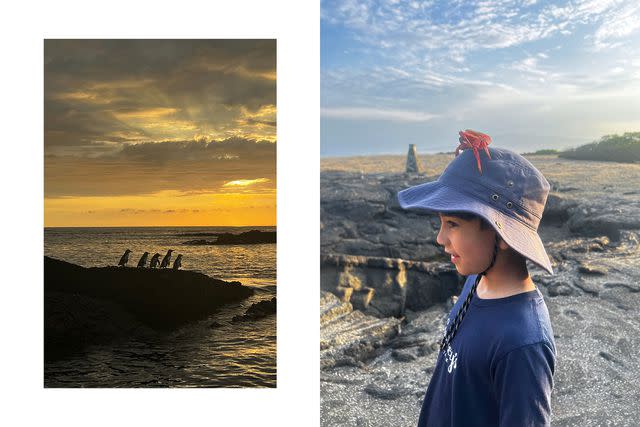
Courtesy of Jacqueline Gifford
From left: A parade of penguins; the author’s son, Bobby, with a Sally Lightfoot crab.On our voyage, the ages spanned from five to 80, and the kids all became fast friends. Managing the entire group — expectations, abilities, learning styles — fell to our naturalist guides, Dolores Villacreses and Monica Reck, who have more than 35 years of experience between them. By law, all visitors must be accompanied by one certified guide for every 16 people. On the Grace, Quasar staffs one for every eight.
As we approached Genovesa Island, a horseshoe-shaped volcanic spit, I took one look at Prince Philip’s Steps — a natural rock staircase, some 82 feet high — and questioned whether we would survive the climb. We began to ascend, and Reck intuitively reached back to grasp our hands while Villacreses pushed forward with the more able passengers, winding past great frigate birds, the males’ red throat pouches puffed like balloons. Bobby couldn’t help approaching them for a closer look, as Reck delicately explained that the inflatable pouches were part of a mating ritual. (I gladly let her handle that one.) Before long, the humidity got to all of us, but both guides knew when to pause, allowing us to catch our collective breath in a massive lava-rock field. It was a humbling theater, as hundreds of storm petrels danced overhead with the Pacific as a backdrop.
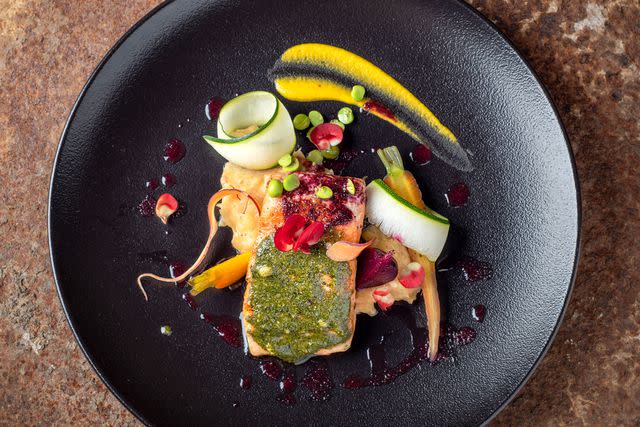
Courtesy of Quasar Expeditions
Grilled salmon with vegetables aboard the Grace.There was a rhythm to every day, one that allowed us to push our personal boundaries. Wake before dawn. Breakfast. Excursion. Snack. Excursion. Lunch, sometimes with a show. More excursions. As we sailed from the northern shore of Isabela Island, lunching on grilled fish and vegetables, a super-pod of dolphins appeared on the horizon. With the captain steering us around them in hot pursuit, Bobby promptly dropped his half-eaten burger and moved to the bow with the other kids. They stood spellbound, elbow-to-elbow, watching hundreds of the mammals catapult out of the water in unison. Social creatures, watching other social creatures.
Later that afternoon, Bobby stayed on board while Rob and I opted to hike a trail past Darwin Lake near Tagus Cove, a quiet port on Isabela. Graffiti is etched on the cliffs from sailors and visitors long gone: indeed, Charles Darwin visited this exact spot on the Beagle in 1835.
Freed from childcare and soothed by the slight break in humidity thanks to a late afternoon shower, I listened for finches. I spent time with a fellow passenger, also a mother and New Yorker: small talk that somehow felt less small out there. I remembered when I read On the Origin of Species for high school biology, a class I really loved. “We want to share this place with the world,” Reck said to me over an afternoon coffee. “But the Galápagos has to be managed so that we make the least impact, to keep it as pristine as it is for as long as possible.”
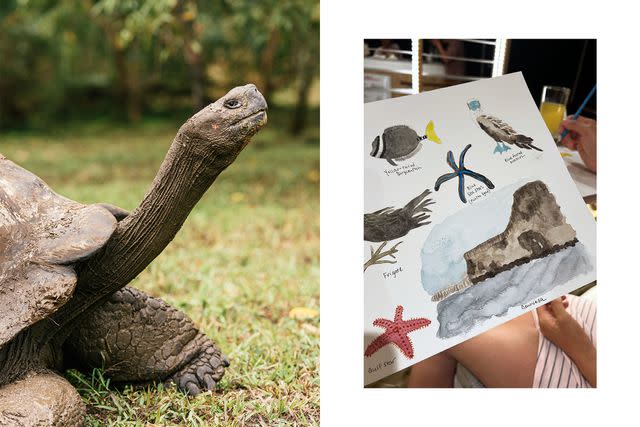
From left: Matt Dutile; Courtesy of Jacqueline Gifford
From left: A Galápagos tortoise on Santa Cruz Island; watercolors by another passenger on the author’s trip.Most travelers, I would guess, are like me: we go to the Galápagos to be displaced, to stumble upon lumbering, 100-year-old tortoises; hordes of marine iguanas that drape over each other like quilts; skittering orange Sally Lightfoot crabs. We go to the Galápagos to believe that time travel is possible, that things can look and behave exactly as they did in 1835. There is an abundance there that I have not seen in many years.
Just before we snorkeled the cool waters off Puerto Egas, a heart-stopping black-sand beach on Santiago Island, I picked up my wildlife book. I wanted to prepare us in case we saw the lightning-quick shark or the otherworldly seahorses. (I did catch one flick of a shark, but zero seahorses.) Nothing could compare with the giant school of silvery black-striped salema, a humble fish that doesn’t get a lot of airtime but is critical to the whole ecosystem. There were hundreds, maybe thousands — I gave up trying to keep score. I squeezed Bobby’s hand, and we both reached out to try and hug them close.
Eight- or 15-day Galápagos cruises with Quasar Expeditions start at $7,300.
For more Travel & Leisure news, make sure to sign up for our newsletter!
Read the original article on Travel & Leisure.

